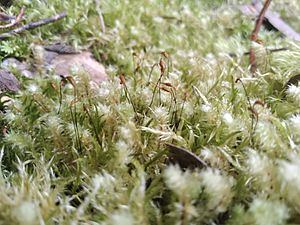Ptychomnion aciculare facts for kids
Quick facts for kids Ptychomnion aciculare |
|
|---|---|
 |
|
| moss at Mount Imlay, Australia | |
| Scientific classification | |
| Genus: |
Ptychomnion
|
| Species: |
aciculare
|
| Synonyms | |
|
|
Ptychomnion aciculare is a type of moss often called ‘Pipe-cleaner Moss’. You can find it mostly in Australia, New Zealand, New Caledonia, Samoa, the Juan Fernandez Islands, and Chile. It gets its fun name because it looks a lot like a pipe-cleaner, especially when it's a bit dry. This name is well-known in Australia and New Zealand. This moss can grow in many places, from right by the sea up to high mountain areas (about 1200 meters or 3,900 feet).
Sometimes, people might also know this plant as Hypnum cucullifolium or Ptychomnion gracillimum.
What Does Pipe-cleaner Moss Look Like?
Ptychomnion aciculare is one of the most common mosses found in wet and rainforests in the southern part of the world. Its scientific name comes from Greek words: ptychios means ‘folded’ and mnion means ‘moss’.
Where It Grows
This moss usually grows on the ground, especially on rich, dark soil called humus. You can also spot it on fallen trees and logs. Sometimes, it even grows on other plants without harming them; this is called being an epiphyte. It often spreads out to form large, soft mats.
Its Unique Features
It's easy to spot this moss because of its red stems that lie flat (this is called prostrate). Its leaves are arranged in a messy way and are crinkly. They are usually between 2 to 3.5 millimeters long. When the moss is dry, it really does look like a pipe-cleaner!
When it's wet, P. aciculare is a bright green. But as it dries out, it turns more yellow-brown. The moss is usually strong, with stems that stand up straight. The brown stem can be seen for most of its length. The leaves become greener and closer together near the tips of the stems. They have a twisted, shell-like shape. The leaves are wider at the bottom and get narrower towards the tip, growing up to 5 millimeters long.
How Pipe-cleaner Moss Reproduces
This moss has separate male and female plants. This means it is unisexual. The male plants can be full-sized, very small (dwarfed), or even attached to the leaves of other plants. You might need a magnifying glass to see the tiny male parts!
The Sporophyte
You can tell when the moss is ready to reproduce because you'll see a special part called a sporophyte. This looks like a brown stalk, called a seta, standing straight up with a small capsule attached to its top. The seta is usually brown and about 20-30 millimeters long. The capsule is reddish-brown.
When the sporophyte is growing, it's protected by a cap-like cover called a calyptra. Once the sporophyte is fully grown and doesn't need to make its own food anymore, the seta turns brown.
Releasing Spores
As the moss dries, the operculum (a lid on the capsule) starts to open. Inside, there's a ring of teeth called the peristome. When it rains, the peristome soaks up water and opens up. This creates a space in the sporophyte. Then, tiny spores (about 10-12 micrometers in size) can be released. The wind and rain help spread these spores to new places.
Ancient History of Pipe-cleaner Moss
Scientists believe P. aciculare is a very old type of moss. This is because its fossils have been found in ancient sediments from the Early Pleistocene period in Western Tasmania, Australia.
This moss is very similar in its genes and how it looks to another moss called Echinodium hispidum. However, E. hispidum has not been found in such old fossils. This suggests that E. hispidum might be a newer species that developed from P. aciculare over a long time.
What Is Pipe-cleaner Moss Used For?
There aren't many known uses for this specific moss. Sometimes, people use it in flower arrangements as a decoration.
However, mosses in general have many other uses! They can be used as fertilizer to help plants grow, as biofuel (a type of energy), and even in some medicines or products.
Interesting Facts About Pipe-cleaner Moss
While P. aciculare is common, it grows best in southern beech forests. It can also be found in different sizes. Some plants are very small, only about 20 millimeters tall, while others can grow up to 120 millimeters (almost 5 inches) tall! This makes it quite a large type of bryophyte (a group of simple plants like mosses). This is unusual because mosses don't have strong woody tissues or internal water systems like bigger plants.
Threats to Pipe-cleaner Moss
This moss loves to grow in rainforests and other wet forests. Because of this, it doesn't handle fire very well. It's a "late-successional" plant, which means it usually grows in places that haven't been disturbed for a long time. You won't often see it in dry areas, except for some damp grasslands.
Luckily, there are no known major threats to P. aciculare. It's not a main food source for animals, and it's a very common species that grows widely and densely. It doesn't seem to have problems with predators or other pests either.

